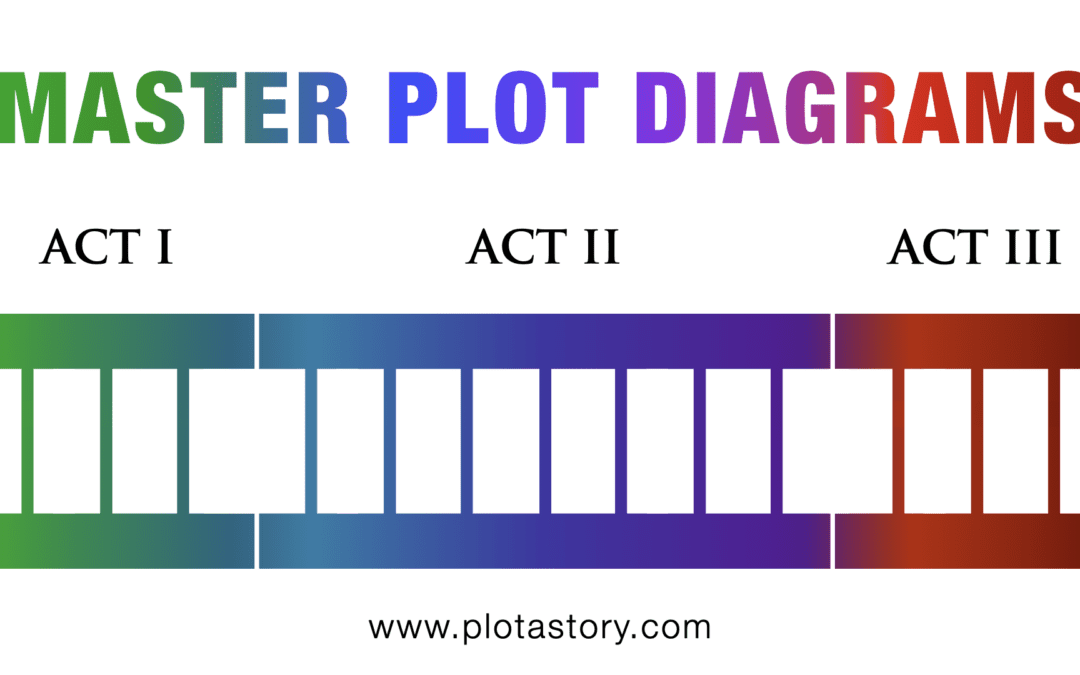Read Time: Grab a snack (16 min)
Mention terms such as plot diagrams or structure to some writers, and they cringe. Such folks tend to believe these models cause the death of spontaneity and creativity.
Nothing could be further from the truth.
In reality, a firm grasp and use of plot diagrams will advance the potential of the writer. Instead of wondering how to plot a story or pace dramatic action, the writer can focus their imagination on character, setting, theme, style, and more.**
Once you become lucid to the three-act structure giving life to plot diagrams, you will see it powering stories everywhere—including bestselling books, blockbuster films, hit shows, binge-worthy podcasts, Broadway productions, top comics, and more.
This plot diagram guide exists to show you the guiding principles of a narrative that moves characters, readers, and your writing from start to finish.
This long-form piece also serves as a tribute to the Master Plot Architects most influential in my lifelong quest to master the craft of storytelling. Most of their frameworks offer percentages with recommended locations and ranges for acts, movements, sequences, and obligatory scenes, however, these percentages are approximations, not formulas.
Plot is a form made up of principles, not rules. Remember this when crafting your own plot.
If you find value in this digital power tool, I encourage you to amplify its reach on the World Wide Web by clicking one of these easy share links:
What is a Plot Diagram?
A plot diagram is a visual blueprint for the plot of a story. At its core,
a plot diagram is a pictorial or graphical representation of the story elements that make up a plot, typically using the three-act structure to illustrate its core principles.
Look at a plot diagram as a bird’s eye view of the dramatic experience of readers. Because fans expect a story to unfold with milestone events that force characters to make impossible choices and take courageous steps. A plot diagram is a vehicle to drive that experience for your fans.
Because right or wrong, audiences have been encouraged for countless years through the page, stage, radio, television, and box office to receive their entertainment using the three-act structure displayed in most plot diagrams.
Why Teach or Learn About Plot Diagrams?
Unlocking the power of plot diagrams will deepen your expertise in the art and craft of storytelling.
First, a plot diagram turns blocks of text into visual measurements of a story.
Most people welcome a combination of learning styles, and some estimates suggest around 65% of people are visual learners, so this supplemental learning method should resonate with most students of storytelling.
Second, you already possess the natural talents needed to generate original ideas, so the comprehension of plot diagrams will only enhance your critical thinking skills when developing your storyline.
Yes, grasping the makeup of plot diagrams allows you to create with inspiration while instinctively applying your analytical skills.
Because if you understand the flow of a designed narrative, you’ll be able to craft stories that are not only logical but also emotionally resonant which leaves a lasting impact on your readers.
Last, I am obsessed with investigating the art and craft of storytelling. And my analytical mind enjoys dissecting the anatomy of a three-act structure or plot diagram. So I am offering my perspective summarizing eight story designs, each receiving a streamlined plot diagram representation.
Is Every Plot Diagram Based on the Same Structure?
Plot diagrams can visualize any type of plot, however, the most powerful plot diagrams usually display the three-act structure based on a story design by a Master Plot Architect (like those included in this visual guide summarizing popular plot structures).
- Each plot diagram in this storytelling guide are broken into three acts.
- Each plot diagram has been developed to help you make connections between the different story designs telling the same overarching plot for a novel, film, or other longform narrative.
A total of eight master plot diagrams are featured in this story development guide. Each plot diagram is listed below including the Master Plot Architects and their associated works used to build each of the story designs:
1. Syd Field’s Paradigm
2. Larry Brooks’ Four Parts
3. James Scott Bell’s 14 Signposts
4. Joseph Campbell’s The Hero’s Journey (featuring Christopher Vogler’s 12 Stages)
5. Michael Hauge’s Six Stages
6. Blake Snyder’s Save the Cat! 15 Beats (with an assist by Jessica Brody)
7. Robert McKee’s Story
8. Gustav Freytag’s Technique
— — —
1. Syd Field’s Paradigm
- Sources: Screenplay: The Foundations of Screenwriting, Newly Revised and Updated by Syd Field, and The Screenwriter’s Workbook: Exercises and Step-by-Step Instructions for Creating a Successful Screenplay, Newly Revised and Updated by Syd Field
In 2001, Syd Field introduced me to the three-act structure in his book, Screenplay. Field’s stylistic description and structural linework of a good screenplay immediately took hold of my creative spirit.
New possibilities became apparent using the storytelling roadmap of Field’s principled guidelines.
So that same year, I sat down in my Southern California apartment to pursue my screenwriting dreams. With a pen in hand and notebook on my lap, I started to create my big story.
30 minutes later, I dropped the pen, closed the notebook, and gave up.
The task overwhelmed me.
Because I didn’t believe I was talented enough to build a big story. My lack of faith killed my writing dreams for almost a decade.
So if story structure begins to hold back your creativity, it’s okay to take some time away from each other, but don’t stop writing as I did. At least keep writing to continue moving forward.
But if you’re still hankering to feed on visuals that drive your story from start to finish, keep reading because the brilliance of Field’s Paradigm is about to shine.
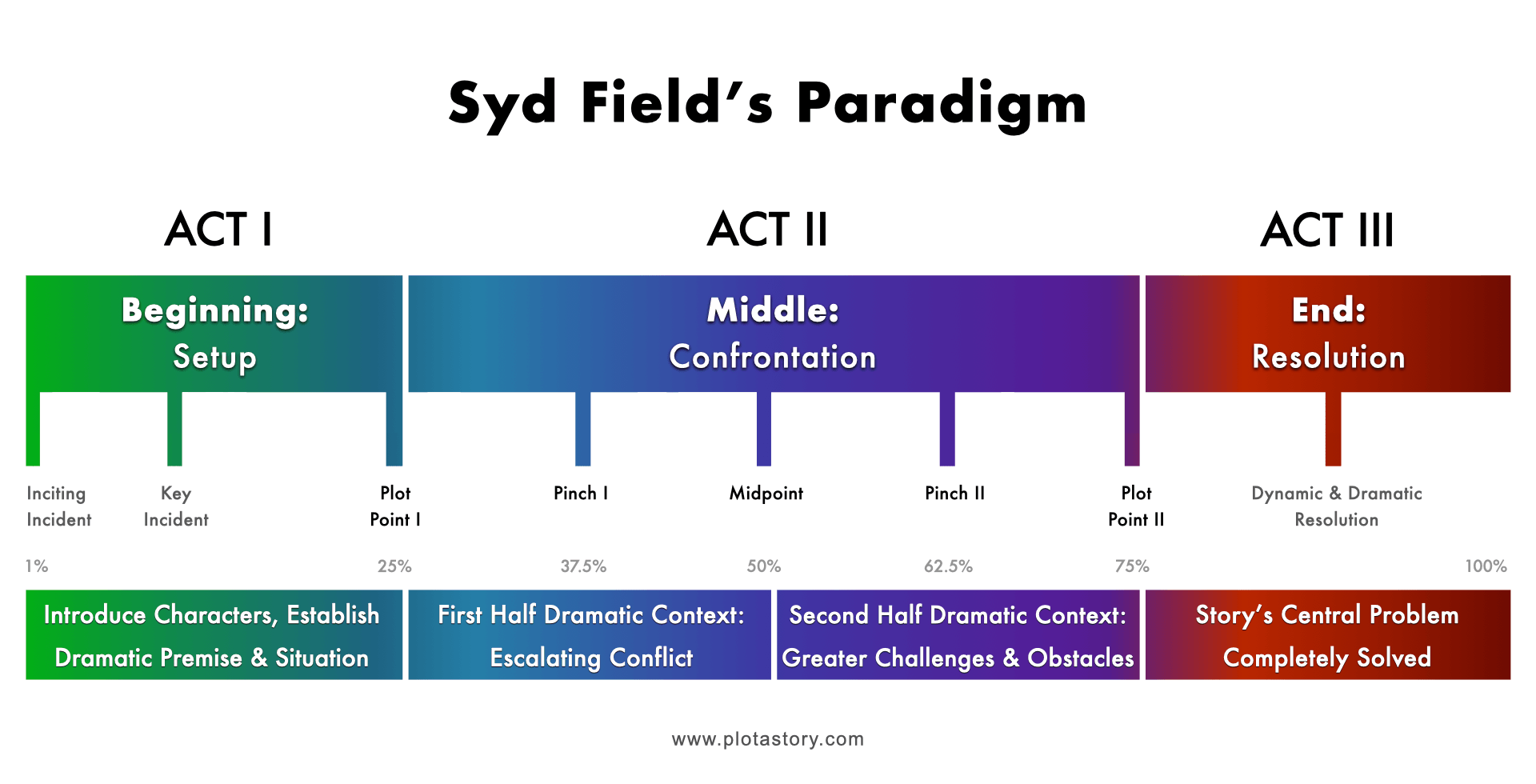
1%—25%
ACT I
Beginning: the Setup
Introduces the main characters, and establishes the dramatic premise and complicated situation.
1%
Inciting Incident:
Attention-grabbing scene or sequence that sets the story in motion while hooking the audience.
10%
Key Incident (optional):
The shifting moment pulls the main character into the storyline and speaks more to what the story is really about.
25%
Plot Point I:
Moves the main character forward to resolve their central problem at hand.
- Syd Field states in Screenplay that a plot point is “any incident, episode, or event that hooks into the action and spins it around in another direction. In this case, Plot Point I moves the action forward into ACT II…”
26%—75%
ACT II
Middle: the Confrontation
The first half of ACT II has a dramatic context of escalating conflict.
37.5%
Pinch I:
Keeps your story on track by giving the storyline (and protagonist) a “pinch” to keep the action moving forward.
50%
Midpoint:
The second half of ACT II employs a dramatic context of greater challenges and obstacles.
62.5%
Pinch II:
In The Screenwriter’s Workbook, Field says this is another “little pinch in the storyline that keeps the action on track, moving the story forward either to the Midpoint” or often the protagonist facing off against the protagonist.
75%
Plot Point II:
Another story progression to move the story forward by using a dramatic shift for the protagonist to make another meaningful advance toward resolving their overarching story goal.
76%—100%
ACT III
End: the Resolution
The end completely resolves the story’s central problem.
Dynamic & Dramatic Resolution:
A key turning point that fits the story by allowing the main character to directly confront and resolve the overarching problem in the plot.
2. Larry Brooks’ Four Parts
- Sources: Story Engineering: Mastering the 6 Core Competencies of Successful Writing by Larry Brooks, and Story Fix: Transform Your Novel from Broken to Brilliant by Larry Brooks, forward by Michael Hauge
In 2011, my first visual story guide came to life thanks to inspiration from Story Engineering by Larry Brooks.
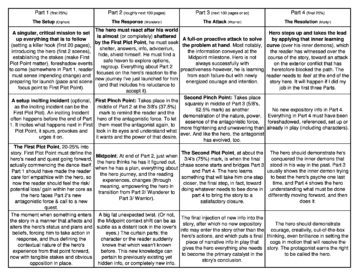
Much like Syd Field, Larry Brooks divides Act II into two parts, thus the three-act structure becomes Larry Brooks’ Four Parts of Story Structure. See below for a brief description of his development approach to building plot architecture.
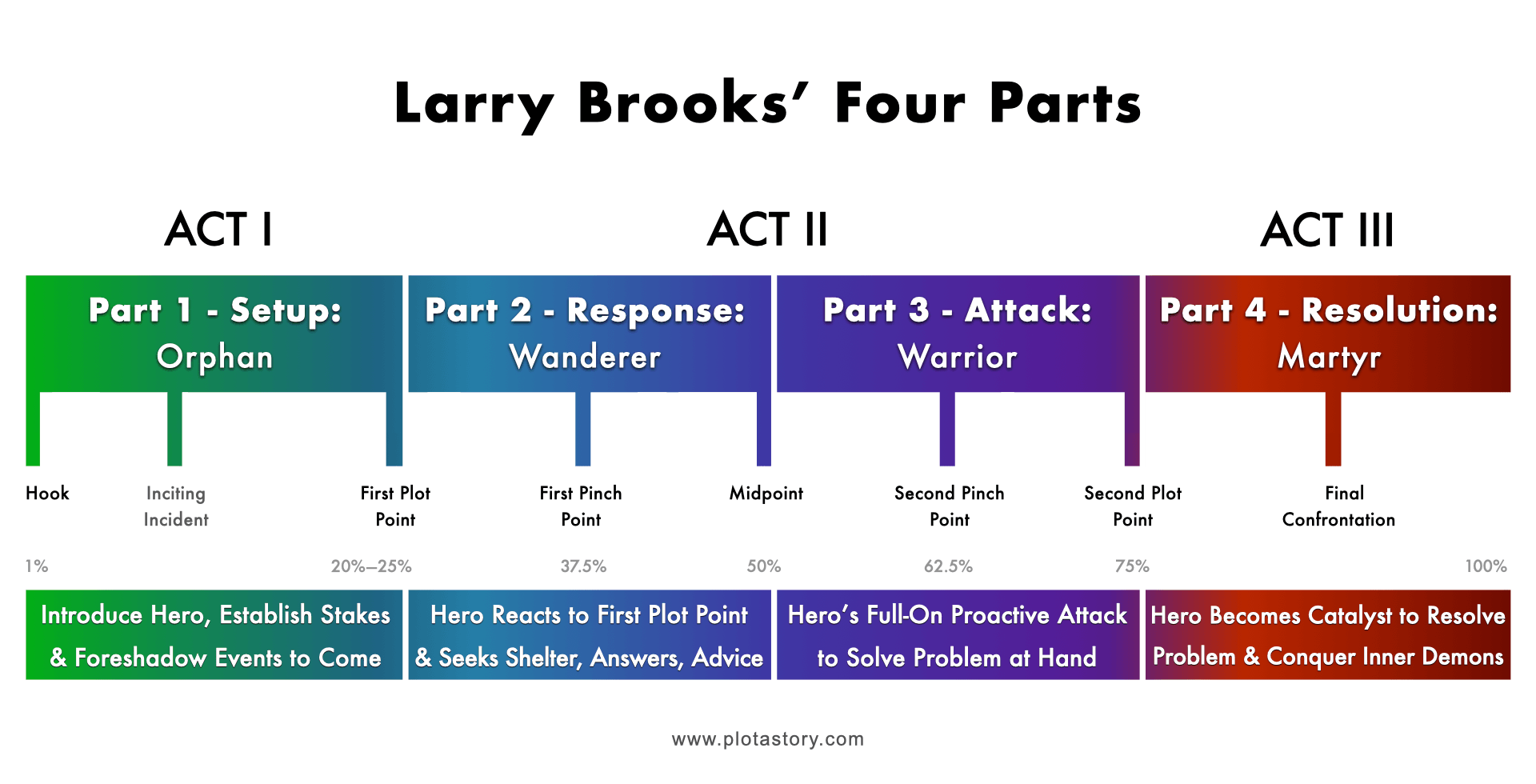
1%—25%
ACT I
Setup: the Orphan
ACT I introduces the hero, establishes their stakes, and foreshadows the dramatic events to come.
1%
Hook:
Grabs the reader by promising an intense and satisfying experience ahead.
10%
Setup Inciting Incident (optional):
Changes things for the protagonist and injects major story elements, a setup for the huge shift coming at the first plot point.
20-25%
First Plot Point:
Changes everything for the protagonist by launching them on their overarching story goal.
26%—50%
ACT II
First half of Act II
Part 2: the Wanderer
The first half of ACT II involves the hero reacting to the first plot point launching them on their overarching story goal, so they seek shelter, answers, and advice to move forward.
37.5%
First Pinch Point:
The antagonistic force is given a full frontal view so the reader can clearly see the true threat and high-stakes conflict opposing the protagonist from reaching their overarching story goal.
50%
Midpoint:
Facilitates dramatic tension by pulling back the curtain of awareness for the protagonist, reader, or both, by revealing new information connected to the protagonist’s overarching story goal.
51%—75%
ACT II
Second half of Act II
Part 3: the Warrior
The second half of ACT II includes the hero’s full-on attack to solve their overarching story goal, still coming up short of its resolution, but aggressive in nature
Hero’s full-on proactive attacked
62.5%
Second Pinch Point:
The main antagonistic force is once again showcased to display its elevated threat level and expanded power threatening to prevent the protagonist from achieving their overarching story goal.
75%
Second Plot Point:
Increases the stakes and accelerates the pace and tension by revealing a final missing piece essential to the protagonist’s overarching story goal.
76%—100%
ACT III
Resolution: the Martyr
The end completely resolves the story’s central problem.
90%
Final Confrontation:
The protagonist’s overarching story goal is determined when they confront the antagonistic force in an epic climax.
3. James Scott Bell’s 14 Signposts
- Sources: Plot & Structure: Techniques and exercises for crafting an engaging plot that grips readers from start to finish by James Scott Bell, and Super Structure: The Key to Unleashing the Power of Story (Bell on Writing) by James Scott Bell
Have you ever believed in the big lie?
For almost a decade, I fell victim to the big lie that says great writers and storytellers were born and not made.
But in 2009, James Scott Bell’s Plot & Structure helped me take a clear assessment of my headspace, and shortly thereafter, I once again started to fill my page breaks.
Thank you James Scott Bell for helping me overcome this invisible script holding me back. And these are Bell’s 14 Signposts as detailed in his book, Super Structure: The Key to Unleashing the Power of Story.
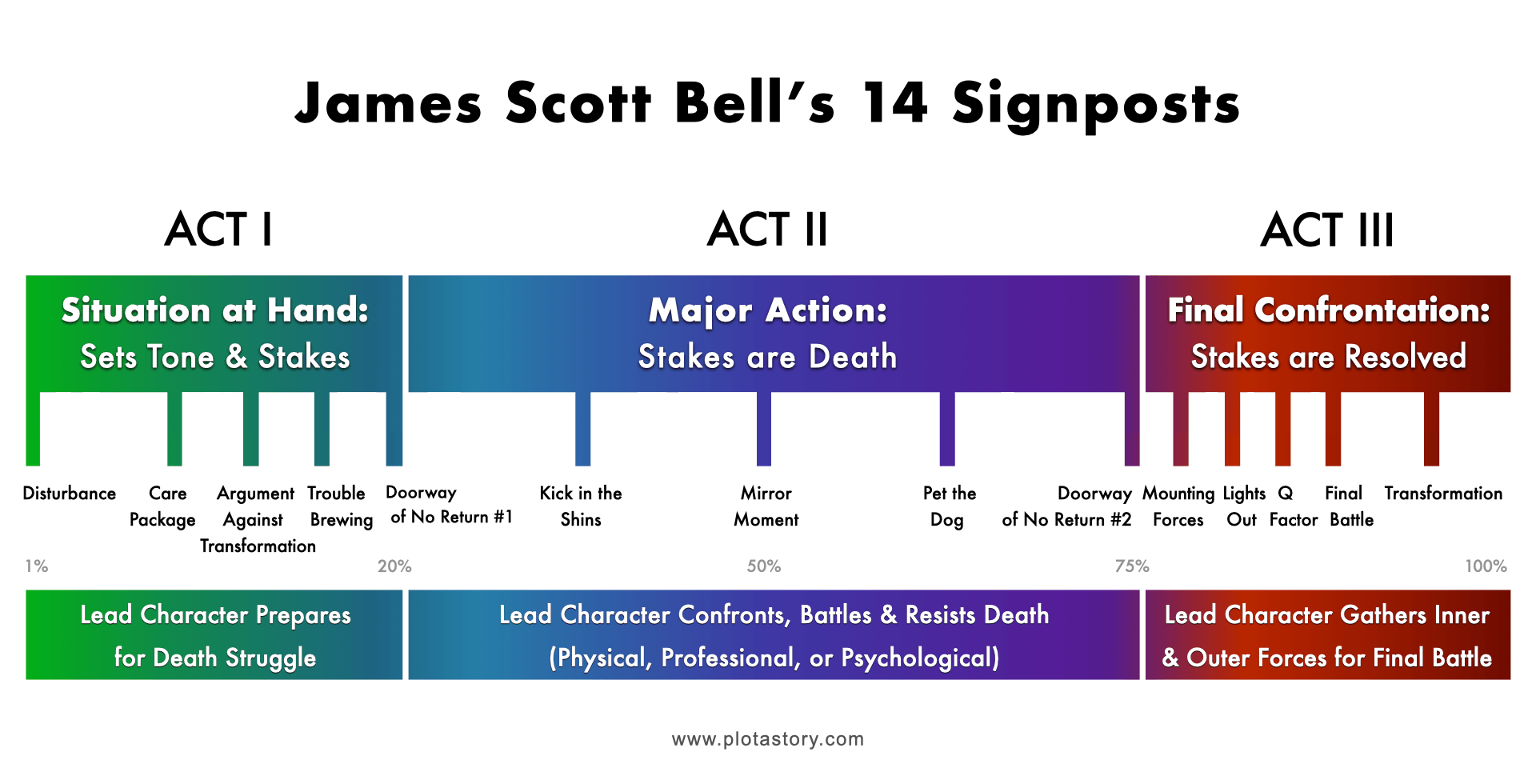
1%—20%
ACT I
Situation at Hand: Sets Tone & Stakes
ACT I introduces the main characters, establishes their death stakes (physical death, professional death, or psychological death), and foreshadows the dramatic events to come.
1%
Disturbance:
An opening shot that shows a character experiencing a big disturbance in their ordinary world.
Care Package:
A relationship the lead character has with another story element (person, place, or thing) that the lead character cares about.
Argument Against Transformation:
Established the lead character’s argument against their own transformation (related to the story’s theme and the lead character’s overarching story goal they may not want to accept but must find the courage to face and overcome).
Trouble Brewing:
A big whiff of the trouble to come, a sense of the high-stakes conflict, is hinted at and floated to the top of readers’ minds.
20%
Doorway of No Return #1:
The lead character makes the decision to walk away from their ordinary world and go down the rabbit hole into a new unknown world.
21%—75%
ACT II
Major Action: Stakes are Death
The lead character confronts, battles, and resists death on one of three levels including physical death, professional death, or psychological death.
Kick in the Shins:
The leader character faces a meaningful obstacle in their overarching story goal which serves as “the first real test in the death stakes of Act II” according to Bell.
50%
Mirror Moment:
The moment when the lead character figuratively looks at themself (as if looking in a mirror), resulting in the confrontation of a dark truth: change or die (physically, professionally, or psychologically).
Pet the Dog:
A moment when the lead character takes time out of their own troubles to help another story element (person, place, or thing) in greater need or weaker than them.
75%
Doorway of No Return #2:
The lead character walks through another significant door due to new information or dramatic action that moves them closer to the final battle and resolution.
76%—100%
ACT III
Final Confrontation: Stakes are Resolved
The lead character digs deep and gathers the inner and outer forces necessary for the final battle.
Mounting Forces:
A key moment that triggers the lead character and readers to stay aware that the final battle is inevitable and around the corner.
Lights Out:
The moment where it appears the lead character cannot possibly survive and win their struggle with death.
Q Factor:
Something the lead character can use later in the story. Named after the character who in the James Bond movies often shares key information at the beginning to foreshadow future story elements, this moment can be built up throughout the overarching story, or it can be deployed in a scene when the hero needs the most help.
Final Battle:
The lead character must face the psychological battle and confront the antagonistic force in a final battle of death stakes.
Transformation:
A final note to show the lead character has changed in a major and dramatic way resulting in their growth and development.
4. James Campbell’s The Hero’s Journey (featuring Christopher Vogler’s 12 Stages)
- Sources: The Hero with a Thousand Faces (Collected Works), 3rd edition by Joseph Campbell, and The Writer’s Journey: Mythic Structure for Writers, 3rd edition by Christopher Vogler
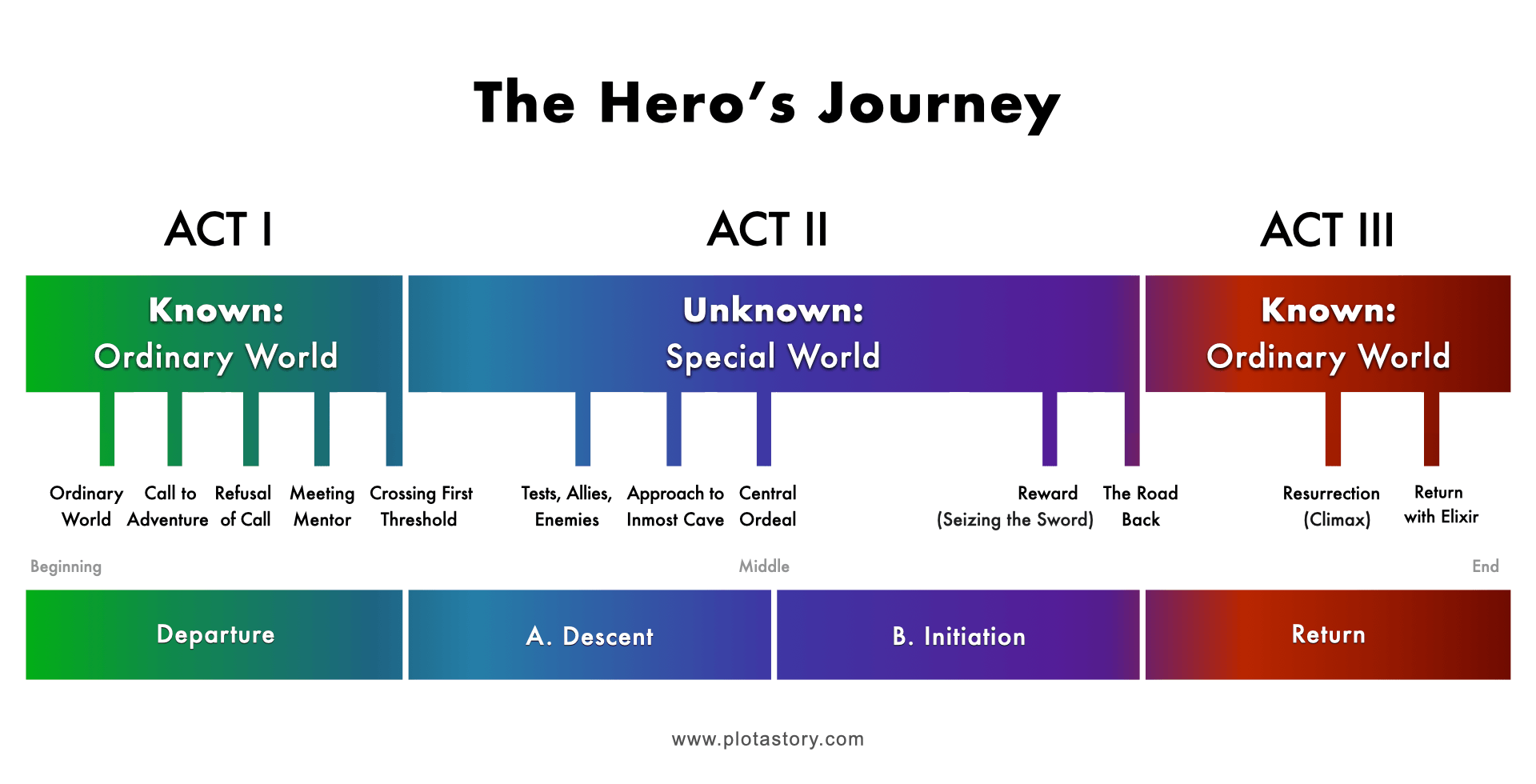
ACT I
Known: Ordinary World including the Departure
Departure fills the opening movement of Act I where the protagonist receives a call to adventure or is presented with a problem or challenge that sets them on the path to their ultimate goal. This marks the beginning of their journey and the separation (departure) from their ordinary life and comfort zone.
The Ordinary World:
The protagonist’s normal life and environment, before their journey begins.
The Call to Adventure:
The event or problem that sets the protagonist on their journey.
Refusal of the Call:
The protagonist’s initial reluctance or resistance to embark on the journey.
Meeting with the Mentor:
The protagonist meets a wise and experienced figure who provides guidance and training.
Crossing the Threshold:
The point at which the protagonist commits to the journey and leaves their familiar world behind.
First half of Act II
ACT II
Unknown: Special World including the Descent
The first half of Act II includes the Descent movement where the protagonist encounters a series of obstacles and challenges that test their courage, skills and determination. They may face physical and mental struggles, and perhaps even failure, as they confront their inner demons and the darker aspects of themselves.
Tests, Allies, Enemies:
The protagonist faces various challenges and meets both helpful allies and hostile enemies.
Approach to the Inmost Cave:
The protagonist nears the climax of their journey and the most dangerous point of their quest.
Central Ordeal:
The protagonist faces their ultimate test and the moment of greatest danger.
Second half of Act II
ACT II
Unknown: Special World including the Initiatation
The second half of Act II is the Initiation movement where the protagonist undergoes a transformative experience, learning important lessons and gaining new abilities or knowledge. The Initiation movement serves as the turning point in the hero’s journey and sets the stage for the hero to confront the final challenge during the Return movement.
Reward (Seizing the Sword):
The protagonist achieves their goal and receives the reward for their efforts.
The Road Back:
The protagonist begins the return journey home.
ACT III
The Road Back to the End
Known: Ordinary World including the Return
The Return movement fills the entirety of Act III where the protagonist faces their ultimate test and proves their worth as a hero by using all of the knowledge and skills they have acquired in their journey.
Resurrection (Climax):
The protagonist experiences a transformation or a rebirth, having been changed by their journey.
Return with the Elixir:
The protagonist returns home and shares their newfound knowledge or treasure with their community.
5. Michael Hauge’s Six-Stage Plot Structure
- Sources: Six Stage Plot Structure Chart (PDF) by Michael Hauge, and The Hero’s Two Journeys (Streaming Video) with Michael Hauge and Christopher Vogler
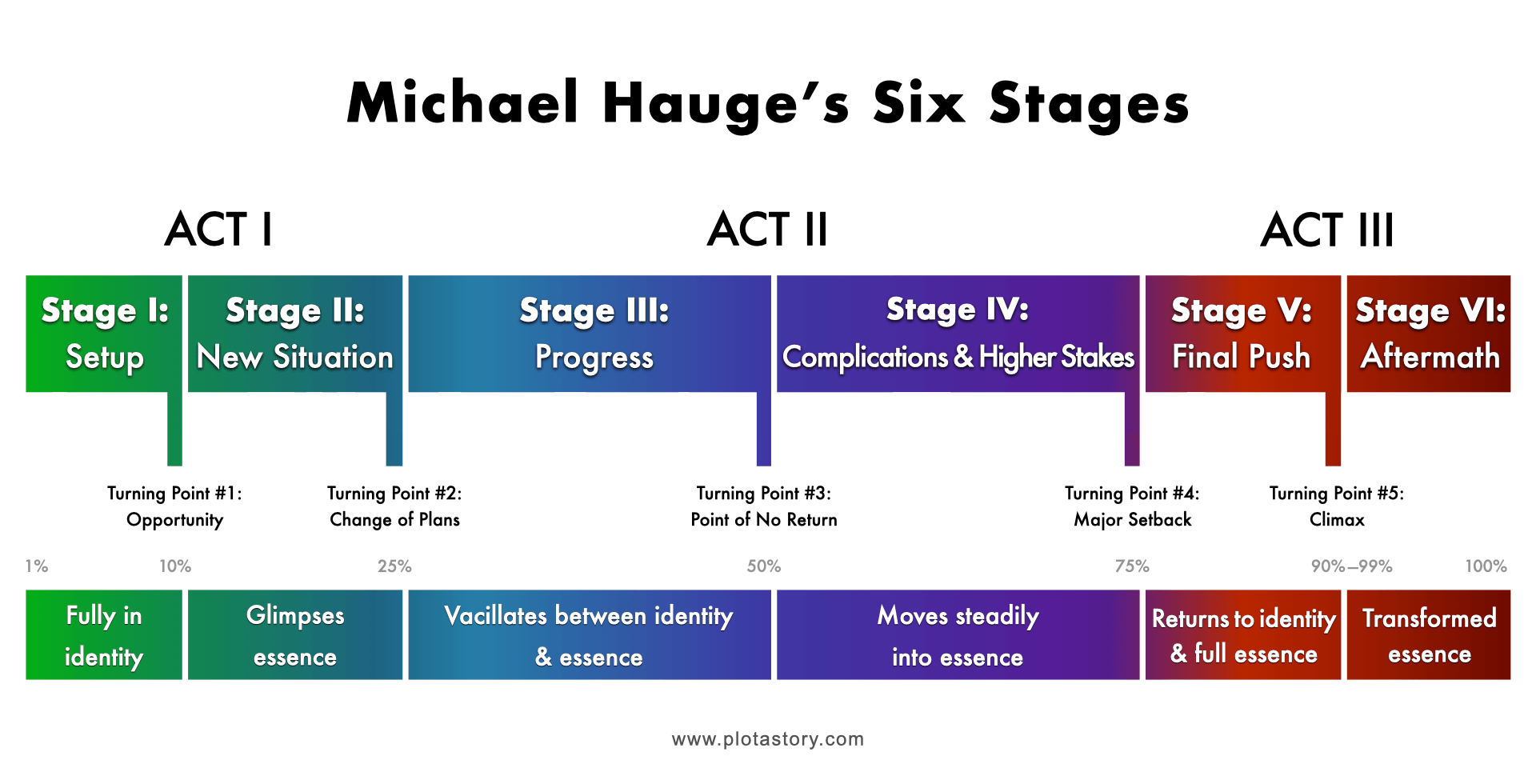
1%—10%
Act I
Stage I: Setup
The protagonist is living fully in identity.
10%
Turning Point #1: Opportunity
The protagonist is presented with a goal or desire that sets the story in motion.
10%—20%
Stage II: New Situation
Glimpsing, Longing, or Destiny: Glimpse of living in essence.
25%
Turning Point #2: Change of Plans
The protagonist makes a decision to fully pursue their goal and changes their course of action.
25%—50%
Stage III: Progress
Protagonist vacillates between identity and essence by moving toward essence without leaving identity.
50%
Turning Point #3: The Point of No Return
The protagonist commits to their goal and can no longer go back to their old life.
50%—75%
Stage IV: Complications & Higher Stakes
Protagonist moves steadily into essence while fully committed to essence but growing fear.
75%
Turning Point #4: Major Setback
The protagonist experiences a significant setback that challenges their resolve and forces them to re-evaluate their plan.
75%—90%
Stage V: Final Push
Protagonist is living one’s truth with everything to lose while retreating to identity and then returning fully to essence.
90%—99%
Turning Point #5: Climax
The protagonist faces their antagonist in a final challenge where the conflict reaches its peak, leading to the resolution of the story.
90%—100%
Stage VI: Aftermath
The protagonist possesses transformed essence with the journey complete and destiny achieved.
6. Blake Snyder’s Save the Cat! 15 Beats (with an assist by Jessica Brody)
- Sources: Save the Cat! The Last Book on Screenwriting You’ll Ever Need by Blake Snyder, and Save the Cat! Writes a Novel: The Last Book on Novel Writing You’ll Ever Need by Jessica Brody

1%—20%
Act I
Thesis: Status Quo World
The introduction of the protagonist’s ordinary life and the normal world in which they live before their main storyline is launched.
1%
The Opening Image:
Establishes the world and tone of the story.
5%
Theme Stated:
The theme is explicitly stated or hinted at.
1%—10%
Set-Up:
Introduces the main characters and their normal world.
10%
Catalyst:
An event or incident disrupts the main character’s normal world and sets the story in motion.
10%—20%
Debate:
The main character struggles with whether to act or not.
20%
Break into Two:
The main character makes a decision and the story’s direction is established.
20%—80%
Act II
Antithesis: Upside-Down World
The protagonist’s normal world is turned upside-down and they are thrust into new and unfamiliar circumstances as they pursue their goal, leading to a series of obstacles and challenges that test their courage, skills, and determination.
22%
B Story:
Introduces a secondary storyline that runs parallel to the main story.
20%—50%
Fun and Games:
The main character faces challenges and obstacles in pursuit of their goal.
50%
Midpoint:
The main character experiences a significant change in their understanding of their situation.
50%—80%
Bad Guys Close In:
The stakes are raised as the main character’s opposition becomes more formidable.
75%
All Is Lost:
The main character experiences a setback that makes it seem impossible for them to achieve their goal.
75%—80%
Dark Night of the Soul:
The main character reaches their lowest point and doubts their ability to succeed.
80%
Break into Three:
The main character finds a new solution or perspective that allows them to take action again.
80%—100%
Act III
Synthesis: Merged Worlds
The protagonist is now equipped with the information, experience, and willpower needed to face the final challenge and achieve their goal, merging the ordinary and upside-down worlds into a new reality, where the protagonist’s inner growth and outer journey come together, leading to the resolution of the story.
80%—100%
Finale:
The main character achieves their goal or faces the consequences of their actions.
99%—100%
Final Image:
The main character achieves their goal or faces the consequences of their actions.
7. Robert McKee’s Story
- Source: Story: Style, Structure, Substance, and the Principles of Screenwriting by Robert McKee
McKee says “Structure is a selection of events from the character’s life stories that are composed into specific emotions and to express a specific view of life.”
He goes on to detail how an “event” really means change and “story events” must generate meaningful change in a character’s life situation. And this meaningful change is expressed and experienced through “story values” which McKee says are “universal qualities of human experience that may shift from positive to negative, or negative to positive, from one moment to the next.”
McKee’s words sing from the page, yet I’ve always found his story elements to be the most difficult to illustrate through my own visual description.
McKee offers his own visual plot diagrams for his original concepts. His worldwide tours may offer updated visuals but I have been unable to find them.
So his plot diagram requires the most comprehension of nuance to grasp its simplicity.
Robert McKee uses several more terms to describe a Story such as the Central Plot or the Spine which is similar to the Quest.
Also, McKee only provides one core percentage range which speaks to the Act I Climax and the Quest typically being launched within the first 25% of the story.

1%—25%
Act I
Opening Movement
Introduces the protagonist, establishes the normal world of the main characters, and an Inciting Incident happens that forces the protagonist to take action and begin sets the story in motion.
Inciting Incident:
A scene, sequence of scenes, or entire movement of sequences occurring as soon as possible in Act I that serves as the “big hook” and drives the protagonist toward the Act I Climax.
Act I Climax:
Launches the protagonist on their Quest for their Object of Desire against forces of antagonism (inner, personal, extra-personal).
25%
The Quest for the Conscious and /or Subconscious Object of Desire:
The protagonist embarks on their Quest which forms the Spine of the story, also known as the Super-Objective which is the energy of a protagonist’s desires.
Act II
Mid-Movement
Characters experience Progressive Complications which make life difficult for the protagonist in pursuit of the Quest for the Object of Desire. McKee says rising action occurs through the protagonist by “arousing forces of antagonism from his inner, personal, or social/environmental Levels of Conflict that block his object of desire.”
Act II Climax:
The turning point that is absolute and irreversible with the greatest tension in the story, where the protagonist reaches a crisis point and must make a crucial decision that will determine the outcome of the story. This is often referred to a “point of no return” where the protagonist’s actions will have unstoppable consequences.
Act III
Acceleration
A movement of scenes with a swift rising action gives the audience a sense of acceleration toward the Crisis.
Crisis:
McKee says, this “dilemma confronts the protagonist who, when face-to-face with the most powerful and focused forces of antagonism in his life, must make a decision to take one action or another in a last effort to achieve his Object of Desire.”
The Crisis is the story’s obligatory scene with a Crisis Decision where the willpower of the protagonist is severely tested.
Climax:
The fourth of the give-part structure, this action serves as a major reversal in the story and produces meaningful emotions in people’s hearts.
Story Climax:
The last act climax which brings about total and irreversible change, answers all or most questions related to the Central Plot, and satisfies all emotions of the audience.
Resolution:
The fifth of the five-part structure is any scene or sequence of scenes remaining to tell the aftermath or tie up any loose ends following the Story Climax.
Resolution:
Addresses any leftover pieces of subplot to close the final loop for audience members, but their meaning is never decreasing in magnitude.
8. Gustav Freytag’s Technique (also known as Freytag’s Pyramid)
- Source: Freytag’s Technique of the Drama: An Exposition of Dramatic Composition and Art by Gustav Freytag | Note: Freytag’s Pyramid is the more popular term for Freytag’s Technique.
Most people know Freytag’s Technique as Freytag’s Pyramid is shown in the image below. Its simple framework is famous for illustrating the rising action moving toward the top of a pyramid and the falling action going downward from the middle of a story to its end.

Freytag’s Technique of the Drama: An Exposition of Dramatic Composition and Art is a classic work on story structure and it is considered a key text in the study of dramatic writing. It explains the architecture of drama in terms of Freytag’s Pyramid, which includes a five-part diagram consisting of Introduction, Rising Action, Climax, Falling Action, and Catastrophe
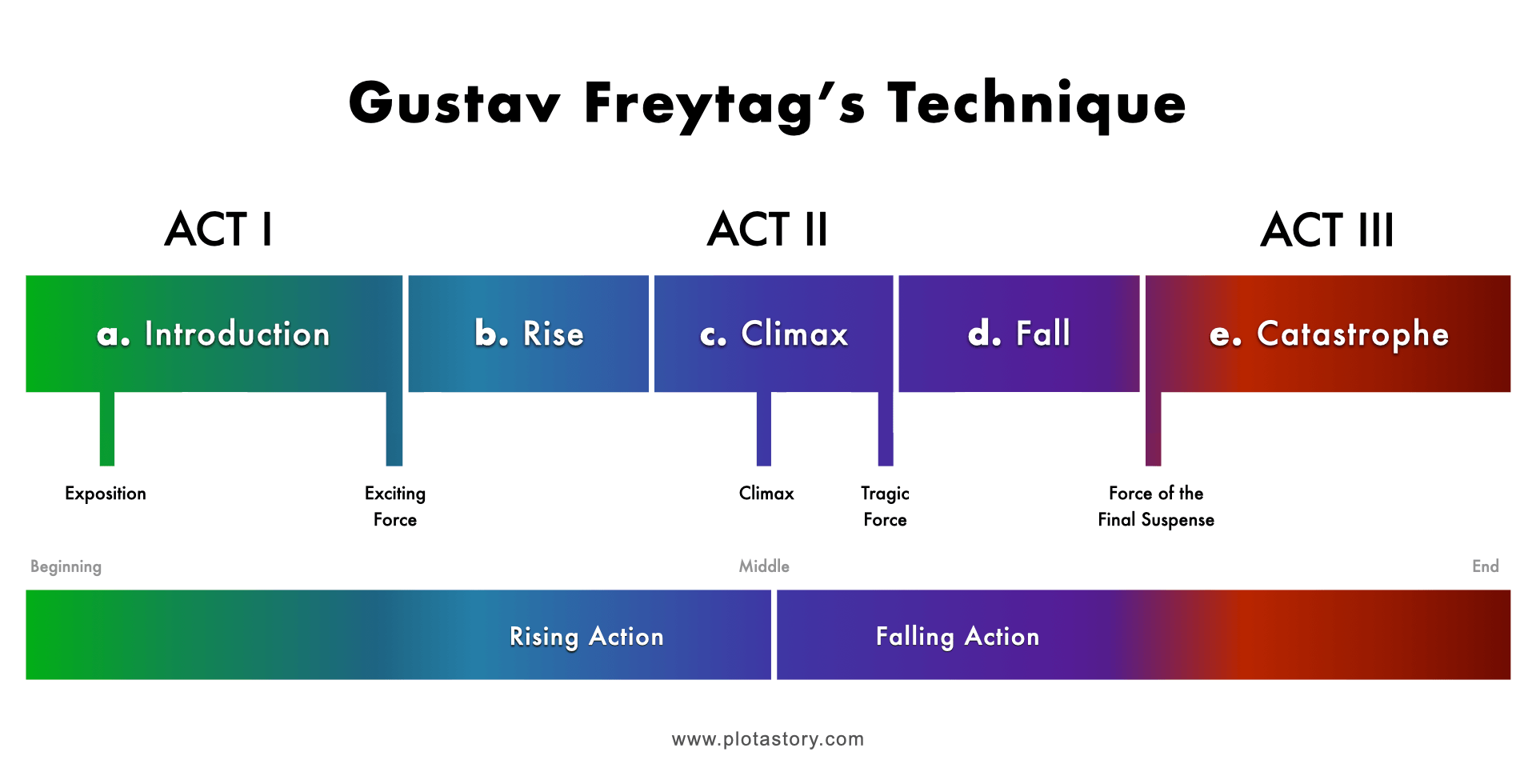
Act I
a. Introduction
The introduction is part of the exposition which is the beginning of a play or story, where the audience is introduced to the main characters, setting, and dramatic situation.
Exposition:
The exposition provides the background information necessary to understand the events that will unfold in the story—including the establishment of the characters, their relationships, and sets the stage for the rising action and central conflict.
Freytag describes the exposition as a crucial part of the dramatic structure because it provides the audience with the information they need to understand the story. He also notes that the exposition should be presented in a clear and concise way, avoiding unnecessary information to keep the audience’s interest.
Exciting Force:
The catalyst often known as the Inciting Incident or Act I Climax that sets the story in motion and propels the characters towards the climax. It is the initial incident or conflict that disrupts the equilibrium of the characters‘ lives and creates the dramatic situation. The Exciting Force continues to increase the rising action and makes the characters take action to resolve the central conflict.
Act II
b. Rise
Freytag’s Technique of the Drama says the movement and rising action “must represent all that is important to the understanding of the (story), in the strong excitement of the characters, and in a continuously progressive increase of effects.”
He goes on to say the rising action movement must “be capable of the strongest dramatic excitement: and this must be universally intelligible.”
c. Climax
The climax of the drama is the moment where the rising movement comes with power and decisiveness to signal the highest significance of dramatic conflict for the characters.
Climax:
The major turning point of the story, where the conflict reaches its highest point, with the climax typically placed at the top of the pyramid, representing the peak of the story’s action and tension. The most important scene in the story where the main character must make a crucial decision in the story.
Tragic Force:
An incident or series of incidents, among the most important points in the story, where the hero is given the deed to react because a tragic force produces new challenges and powerful movement.
Freytag says, “Revolution (Peripeteia), is the name given by the Greeks to that tragic force which by the sudden intrusion of an event, unforeseen and overwhelming but already grounded in the plan of the action, impels the volition of the hero, and with it the action itself in a direction entirely different from that of the beginning.”
d. Fall
The falling action of the story that immediately follows the Climax, where the tension and conflict begin to be resolved. The Climax typically follows the main character’s realization of their mistakes or the consequences of their actions.
Act III
Force of the Final Suspense:
A turning point before the Catastrophe and according to Freytag, “It is well understood that the catastrophe must not come entirely as a surprise to the audience. The more powerful the climax, the more violent the downfall of the hero, so much the more vividly must the end be felt in advance.”
e. Catastrophe
The closing action of a story is called the “exodus.”
The hero is faced with a great crisis which challenges their resolve, purpose, and willpower.
Freytag says the Catastrophe is a “finished scene which either shows the contending forces in the strife with the hero, in the most violent activity, or affords a clear insight into the life of the hero.”
– – – – – – –
** Note: Opening three paragraphs inspired by the opening of Jack M. Bickham’s Scene & Structure (Elements of Fiction Writing)

